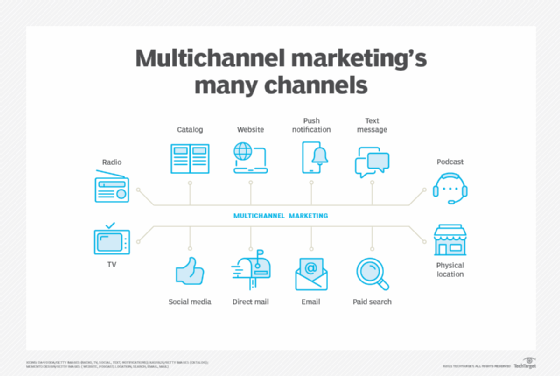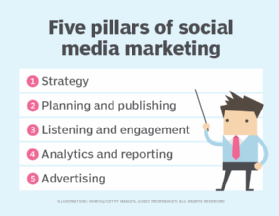buzz marketing
What is buzz marketing?
Buzz marketing is a Viral marketing technique focused on maximizing the word-of-mouth potential of a campaign or product. These strategies can spur conversations among consumers' family and friends or larger-scale discussions on social media platforms. By getting consumers talking about their products and services, companies that employ buzz marketing hope to grow awareness through more online traffic and increase sales and profits.
A buzz marketing example would be if a company promoted its product through a show or stunt where consumers can try the product and share their experiences through everyday conversation or online. Another term for buzz marketing is astroturfing.
Online buzz marketing is typically driven by "influencers." These are early adopters of a product, who are eager to share their thoughts on the product and proactively start conversations about it. These people typically have established online presences and large followings as social media influencers on platforms such as Facebook and Twitter. They possess power and influence over their followers.
Influencers' opinions get noticed more readily and can have a positive effect on product awareness and sales. Marketers aim to rally these influencers to build buzz for their products. Some marketers target people known as connectors. They are big-name personalities and celebrities who can lend instant credibility and exposure to a product. Marketers looking for a large jump in awareness will seek out connectors.

How does buzz marketing work?
Social media marketing is a main component of buzz marketing. Facebook and Twitter are two of the leading social media platforms where companies seek to maintain a presence. Using these and other social media sites, companies can do the following:
- interact with customers
- receive feedback
- address issues or concerns
- promote products and services
Cultivating a rich set of shareable content and amassing a strong following on these sites helps companies get information to existing and potential customers. These approaches also facilitate a real-time dialogue where customers feel valued and informed.
Other online buzz marketing strategies include the following:
- Engaging influential bloggers to create a stir. Companies often let bloggers or media outlets try a product in advance of its release in exchange for a published mention of the product.
- Using website forums to foster conversation or provide answers to frequent questions.
- Creating customer communities that connect fan clubs, message boards and other groups. One medium that works well with this strategy is podcasting. Podcasts often combine an influential host with an already built-in community of followers and accompanying web content.
Buzz marketing is a different approach to content marketing than traditional outbound marketing and the mass marketing tactics of TV, radio and print advertising. In outbound marketing, companies aim to get their messages to as many people as possible with the hope that a few will become interested.

Buzz marketing depends on the power of one-on-one personal messages more than broadcast messaging. It assumes that word-of-mouth marketing holds more weight with consumers because it is perceived as unbiased, coming from people they trust and not simply directly from the company.
One of the challenges of buzz marketing is maintaining the element of surprise as part of the marketing strategy. For example, tweeting absurd, snarky quips from a corporate twitter account catches Twitter users by surprise when that's not what they are used to from that account.
As consumers get better at identifying buzz marketing, marketers must use it sparingly to be effective. This development is similar to early forms of online marketing, such as pop-up and banner ads, which some audiences now consider annoying. However, they still have a role in marketing but also must be used creatively to be effective.
With buzz marketing, companies also run the risk of not being able to connect their campaigns with the brand or product itself. Merely creating content that gets people talking is meaningless if people don't identify it with the company that created it.
Examples of buzz marketing
Examples of buzz marketing include companies creating online videos, centered around something humorous, controversial, unusual or outrageous. In doing this, they hope to cause a sensation and get people talking about the video, sharing it via social media and driving up views on websites such as YouTube. Companies will then try to capitalize on the content's popularity by promoting the product on social media, either by creating a hashtag in the hopes of becoming a "trending topic," or encouraging consumers to download other pieces of content to further foster customer engagement.
Some examples of buzz marketing include the following:
- ALS Ice Bucket Challenge. This social media-based movement involved an individual pouring a container of ice water over their head. The point of the challenge was to promote awareness of amyotrophic lateral sclerosis (ALS), also known as Lou Gehrig's disease. The campaign motivated a surge of donations to organizations like the ALS Association and the ALS Therapy Development Institute.
- Dell on campus. Dell ran a college campus campaign in 2016 to increase brand awareness. It sent brand ambassadors to engage with students and hold more meaningful conversations with them about Dell products. Doing this made for more memorable interactions with the company and kept the brand top of mind with a strategic audience.
- Super Bowl commercials. The Super Bowl is watched by more than 90 million people, and the commercials often generate buzz. Men's deodorant and shower product company Old Spice rebranded its advertising strategy in 2010 to incorporate humorous and outrageous meme-friendly commercials. One commercial had actor Terry Crews shouting and riding a tiger.
- Wendy's. Fast-food chain Wendy's regularly posts on its Twitter account with edgy content roasting other brands like McDonald's. Wendy's also locked its Twitter account, making it available only to followers during a promotion of its new 2020 breakfast options. This strategy generated more followers, motivating individuals to follow the account for the humor. Marketingdive.com reported in 2020 that Wendy's received over 10,000 follower requests in a 36-hour time span after locking its Twitter account. Wendy's also ran a campaign in 2018 where the company created a character in the video game Fortnight to run around and destroy freezers. It was a way to signal that Wendy's never uses frozen beef.
What are the different types of buzz marketing?
Each buzz marketing tactic focuses on a different trigger to get an audience talking. Mark Hughes, who is credited with coining the term buzz marketing, identifies six ways to go about a buzz marketing campaign. Hughes recommends focusing on the following tactics:
- Taboo. Using controversial subjects to generate buzz gets people talking. But this approach also entails risk of negative reactions and backlash. One example is Coca Cola's 2014 It's Beautiful Super Bowl advertisement, which featured the song America the Beautiful sung in nine different languages. Some people reacted negatively on social media, saying the version of the song as unpatriotic and expressing an English-only sentiment.
- Outrageous. Another way to generate buzz is to shock the audience. BlendTec's Will It Blend? YouTube campaign, is an example of an outrageous approach. It features a man in a lab coat putting various items -- Action figures, Amazon Echo, Apple iPhone -- in the blender to obliterate them.
- Hilarious. Humorous ads get people laughing and talking. One example is the Allstate Mayhem commercials that feature Mayhem Man destroying people's personal property to show why someone should buy Allstate insurance.
- Secret. Using secrets to pique interest can generate buzz. When marketing material presents clues to some exclusive information, people's curiosity is peaked. A phrase that sums up this tactic is: "I'm not supposed to tell you this, but …". Facebook is a good example of how this approach works. When it was initially launched, you had to have a personal invitation from another member to join. This created a fear of missing out (FOMO) and excitement around being included.
- Remarkable. This is when a brand attempts to exceed what is expected, demonstrate its values or inspire its audience. Chrysler's Imported from Detroit marketing campaign appealed to the "buy American" sentiment and overcoming hardship and tough times.
- Unusual. This is when a brand frames its product or service as different or unique. When the iPad came out in 2012, Apple positioned it as a new product different from anything on the market.
Best practices for creating a buzz marketing campaign
Buzz marketing is an effective type of marketing in part because people in social settings are perceived to be more trustworthy than companies, which are trying to sell their products. Someone talking about a product or service appears to be doing so because they like it, not because they are trying to sell it.
Best practices to achieve successful buzz marketing include the following:
- Know the target audience. Understand the interests, triggers and boundaries for a campaign's target market.
- Develop a strategy. Match the audience profile with a strategy that will appeal to them.
- Push the right buttons. Make sure that triggers stir as much of a reaction as possible, without offending or turning away audience members.
- Build anticipation. Stimulate the customer's desire to learn more, particularly before the product launch. This generates momentum.
- Encourage early adopters. Reward those who respond positively to the brand early on. This will make some customers feel special while stimulating FOMO or a sense of curiosity in others.
- Embrace influencer marketing. Influencers have pull in large audiences and can generate buzz quickly.
- Monitor the results. Identify and use key performance indicators to track the performance of a digital marketing campaign success. Success measures include brand mentions and followers gained in a certain time. Sentiment analysis tools can reveal how customers are reacting to a campaign.
Getting and keeping the attention of millennials and Generation Zers is important for modern brands. Learn some best practices for influencer marketing to those generations.






